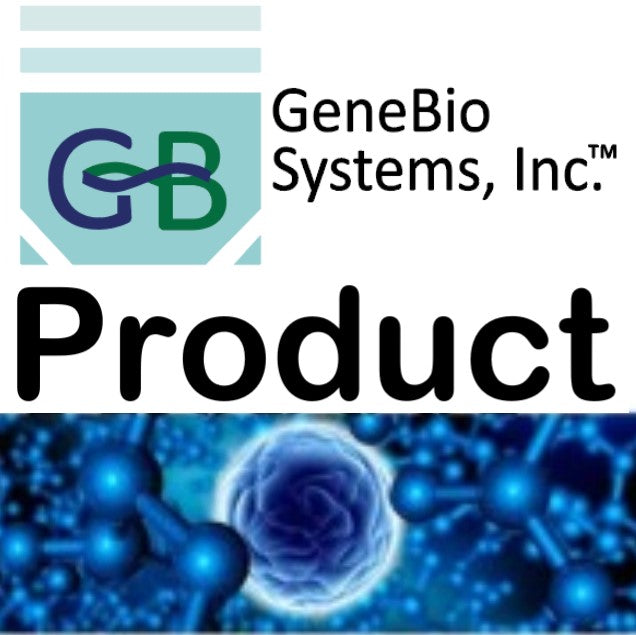Gene Bio Systems
Recombinant Human Neuroserpin protein(SERPINI1) (Active)
Recombinant Human Neuroserpin protein(SERPINI1) (Active)
SKU:CSB-AP000141HU
Couldn't load pickup availability
Size:100ug. Other sizes are also available. Please contact us.
Research Areas:Neuroscience
Uniprot NO.:Q99574
Uniprot Entry Name:NEUS_HUMAN
Gene Names:SERPINI1,PI12
Species:Homo sapiens (Human)
Source:E.Coli
Expression Region:17-410aa
Sequence:TGATFPEEAIADLSVNMYNRLRATGEDENILFSPLSIALAMGMMELGAQGSTQKEIRHSMGYDSLKNGEEFSFLKEFSNMVTAKESQYVMKIANSLFVQNGFHVNEEFLQMMKKYFNAAVNHVDFSQNVAVANYINKWVENNTNNLVKDLVSPRDFDAATYLALINAVYFKGNWKSQFRPENTRTFSFTKDDESEVQIPMMYQQGEFYYGEFSDGSNEAGGIYQVLEIPYEGDEISMMLVLSRQEVPLATLEPLVKAQLVEEWANSVKKQKVEVYLPRFTVEQEIDLKDVLKALGITEIFIKDANLTGLSDNKEIFLSKAIHKSFLEVNEEGSEAAAVSGMIAISRMAVLYPQVIVDHPFFFLIRNRRTGTILFMGRVMHPETMNTSGHDFEEL
Protein Description:Full Length of Mature Protein
Tag Info:Tag-Free
Mol. Weight:44.7 kDa
Biological_Activity:Fully biologically active when compared to standard. The ED50 as determined by a cell proliferation assay using rat C6 cells is less than 0.5 ?g/ml, corresponding to a specific activity of > 2000 IU/mg.
Purity:>95% as determined by SDS-PAGE and HPLC.
Endotoxin:Less than 1.0 EU/µg as determined by LAL method.
Form:Lyophilized powder
Buffer:Lyophilized from a 0.2 µm filtered PBS, pH 7.5
Reconstitution:We recommend that this vial be briefly centrifuged prior to opening to bring the contents to the bottom. Please reconstitute protein in deionized sterile water to a concentration of 0.1-1.0 mg/mL.We recommend to add 5-50% of glycerol (final concentration) and aliquot for long-term storage at -20?/-80?. Our default final concentration of glycerol is 50%. Customers could use it as reference.
Notes:Repeated freezing and thawing is not recommended. Store working aliquots at 4? for up to one week.
Alternative Name/ Alias:Peptidase inhibitor 12, Serpin I1
Relevance:Serine protease inhibitor that inhibits plasminogen activators and plasmin but not thrombin. May be involved in the formation or reorganization of synaptic connections as well as for synaptic plasticity in the adult nervous system. May protect neurons from cell damage by tissue-type plasminogen activator.
PubMed ID:9070919; 14702039; 17974005; 15489334; 10517635
Function:Serine protease inhibitor that inhibits plasminogen activators and plasmin but not thrombin
Involvement in disease:Encephalopathy, familial, with neuroserpin inclusion bodies (FENIB)
Subcellular Location:Secreted, Cytoplasmic vesicle, secretory vesicle lumen, Perikaryon
Protein Families:Serpin family
Tissue Specificity:Detected in brain cortex and hippocampus pyramidal neurons (at protein level) (PubMed:17040209). Predominantly expressed in the brain (PubMed:9070919).
Paythway:
HGNC Database Link:https://www.genenames.org/cgi-bin/gene_symbol_report?hgnc_id=HGNC:8943
UniGene Database Link:https://www.ncbi.nlm.nih.gov/UniGene/clust.cgi?ORG=Hs&CID=478153
KEGG Database Link:https://www.genome.jp/dbget-bin/www_bget?hsa:5274
STRING Database Link:https://string-db.org/network/9606.ENSP00000295777
OMIM Database Link:https://www.omim.org/entry/602445602445602445


